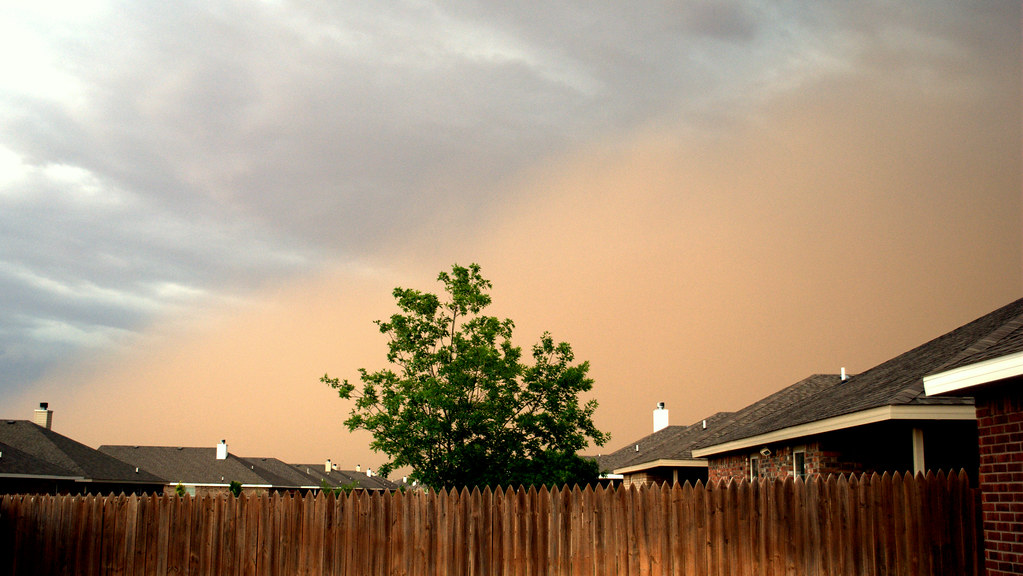
PHOENIX — The American Southwest, a region defined by its vast arid landscapes and dramatic weather phenomena, frequently witnesses colossal walls of dust and debris, known as haboobs, that roll across its expanse. These natural events, while awe-inspiring in their sheer scale, often transition swiftly into terrifying ordeals for the communities and motorists caught within their path, transforming sunlit days into an eerie, suffocating twilight.
Recent events in Phoenix have brought the formidable power of haboobs into sharp focus, with a massive dust storm plunging parts of the metropolitan area into near-total darkness, grounding flights, and disrupting essential services for thousands. Such occurrences underscore the complex interplay between atmospheric conditions, geographical characteristics, and human habitation in an environment increasingly shaped by climatic shifts. Understanding these storms is paramount for residents and policymakers alike as they adapt to the challenges posed by an unpredictable natural world.
This article aims to provide an in-depth examination of haboobs, dissecting their meteorological origins, their immense physical dimensions, and their prevalence across the Southwest. It will also explore the critical distinctions that define these dust storms, the ongoing scientific discussions about their relationship with a changing climate, and the crucial safety measures advised by authorities to mitigate their immediate dangers to the public.

1. **Defining the Haboob: A Meteorological Phenomenon**: Haboobs represent a specific and dramatic form of dust storm, distinguished by their formation mechanism. These massive walls of dust and debris are fundamentally spawned by thunderstorms, a common occurrence in arid regions during specific seasons. The term ‘haboob’ itself, derived from the Arabic word ‘habb,’ meaning ‘to blow,’ aptly describes the driving force behind these immense atmospheric events.
Central to the genesis of a haboob is the powerful atmospheric process known as a downdraft. As intense thunderstorms mature, they produce considerable rain and hail. This precipitation, along with the air it drags down, cools rapidly, becoming denser than the surrounding air. When this cooler, denser air descends rapidly, it forms a powerful column, or downdraft, that eventually impacts the ground with significant force.
Upon striking the ground, these downdrafts do not dissipate but rather spread outward in all directions, creating a turbulent, high-speed gust front. It is this horizontal spread of wind that acts as the primary mechanism for scooping up vast quantities of loose dust and dirt from the parched desert floor and agricultural fields, propelling it skyward and outward to form the characteristic towering wall.

2. **The Genesis of Dust Walls: Thunderstorm Downdrafts**: The initiation of a haboob is intimately tied to the dynamics of thunderstorm downdrafts. Sean Benedict, a meteorologist at the National Weather Service’s Phoenix office, explains that these strong downdrafts can hit the ground at speeds ranging from 50 to 80 mph (80-129 kph). Upon impact, the air then spreads radially, gathering momentum and expanding its reach across the landscape.
As these powerful ground-level winds propagate, they become highly effective at stirring up and entraining loose dust and dirt. The arid regions of the Southwest, characterized by expansive areas of dry soil and cultivated farm fields, provide an abundant source of fine particulate matter, which is easily lifted and carried aloft by these forceful air currents.
The persistence and growth of a haboob are also influenced by the atmospheric conditions preceding and following the initial downdraft. If rain-cooled air ahead of the storm continues to push warm air upward, it can generate new thunderstorms and, consequently, more downdrafts. This continuous cycle allows the haboob to sustain itself and expand its formidable presence, moving across vast distances.

3. **Unveiling the Scale: Size, Speed, and Reach of Haboobs**: The visual impact of a haboob is often described as awe-inspiring due to its immense scale. These dust storms can create walls of dust that tower thousands of feet into the sky, dwarfing city neighborhoods and obscuring entire landscapes. Furthermore, their lateral extent can span several miles wide, presenting a truly colossal natural spectacle that transforms the horizon.
Beyond their impressive height and width, haboobs are also characterized by their considerable speed. The driving winds that propel these dust walls can reach 60 mph (97 kpm) or more, allowing them to advance rapidly across the terrain, catching unsuspecting individuals and communities by surprise. This swift progression contributes to the sudden reduction in visibility and the general chaos they can inflict.
The capacity for a haboob to travel vast distances is also a notable characteristic. When conditions are optimal, with continuous thunderstorm development and a landscape prone to generating dust, a haboob can sustain its intensity and travel as far as 100 miles, according to meteorologist Sean Benedict. This extensive reach means that communities far from the initial thunderstorm genesis point can still be significantly impacted by the advancing dust wall.

4. **Geographic Corridors: Where Haboobs Are Most Prevalent**: Haboobs are not a universal phenomenon but are primarily concentrated in specific geographic regions where the necessary climatic and topographical conditions converge. The arid areas of the Southwest United States are particularly prone to these dramatic dust storms, making them a recurring feature of the region’s intense monsoon seasons.
Within the Southwest, certain areas are recognized as prominent ‘dust corridors’ due to their landscape and susceptibility to the wind patterns that generate haboobs. Sean Benedict points to a particularly active corridor situated between Phoenix and Tucson, indicating that the land use and atmospheric dynamics in this stretch of Arizona frequently contribute to the formation and intensification of these storms.
Beyond Arizona, other arid states in the Southwest also experience haboob formations. The National Weather Service reports that these towering dust clouds can also form in the dry expanses of Nevada, New Mexico, and Texas. While haboobs are a distinct and powerful event, the Phoenix area specifically experiences one to three large dust storms annually, highlighting the regularity of such occurrences in this desert metropolis.

5. **Not All Dust Storms Are Haboobs: The Key Distinction**: While the term “dust storm” is often used broadly, it is crucial to understand that not all such events qualify as a haboob. The National Oceanic and Atmospheric Administration (NOAA) and meteorologists like Sean Benedict emphasize a critical distinction based on the storm’s origin and mechanism. A haboob is specifically and intrinsically linked to the powerful downdrafts produced by thunderstorms.
This particular characteristic sets haboobs apart from other types of dust storms that may arise from different meteorological or geographical conditions. For instance, dust can be picked up by strong winds not associated with a thunderstorm’s outflow, or from localized wind events that lack the specific downdraft-driven genesis of a haboob. The defining feature of a haboob is the cold air outflow from a collapsing or mature thunderstorm, which acts as a plowing front to scoop up and propel vast quantities of dust.
Understanding this distinction is not merely an academic exercise; it has practical implications for forecasting and public safety. Meteorologists focus on the development and movement of thunderstorms to predict haboobs, allowing for more targeted warnings and advisories. This precise definition ensures that resources and public awareness are directed towards events with a very specific, and often more dangerous, set of characteristics.
6. **Climate Change and Monsoon Intensity: A Looming Threat?**: The occurrence and intensity of haboobs are increasingly being viewed through the lens of climate change, particularly in the context of the Southwest’s monsoon season. Scientists have observed a shift in monsoon patterns since the 1970s, noting that these localized bursts of summer rain have become more intense as the atmosphere continues to heat up due to human-caused climate change.
This increase in storm intensity, however, is juxtaposed with other concerning trends: it is raining less often, droughts are lasting longer, and some arid areas are expanding. This combination of hotter temperatures, extended dry periods, and more intense, albeit less frequent, storms creates a potent environment that could set the stage for more intense dust storms in the future, including haboobs.
Despite these broader trends, predicting the exact future frequency of haboobs remains a complex challenge for meteorologists. Sean Benedict notes that these storms require a very specific set of circumstances to form and grow. Furthermore, localized factors such as land use, particularly farming practices, significantly affect the amount of loose dust available to be picked up by storm-generated winds, adding another layer of complexity to future projections.

7. **Forecasting the Fury: National Weather Service Warnings**: The rapid onset and severe reduction in visibility associated with haboobs necessitate timely and accurate warnings to protect the public. The National Weather Service (NWS) plays a crucial role in this regard, issuing specific dust warnings when conditions are favorable for these powerful events. These warnings are based on meteorological analysis and an understanding of local dust-prone areas.
The primary criterion for issuing a dust warning is the anticipation that thunderstorms and high winds moving through dust-prone areas could reduce visibility to a quarter mile or less. This threshold is critical because visibility dropping below this level creates extremely hazardous conditions, particularly for motorists, significantly increasing the risk of accidents.
Sean Benedict emphasizes that these warnings are especially vital when conditions are favorable for clusters of storms. Such scenarios can lead to larger, more sustained haboobs with a wider impact zone and prolonged periods of severe low visibility. The NWS’s proactive communication aims to provide residents with sufficient time to take protective measures, underscoring the importance of heeding these advisories when they are issued.

8. **Immediate Chaos: The Plunge into Darkness and Zero Visibility**: When a haboob descends upon a region, the transition from clear skies to near-total darkness is often instantaneous and disorienting. Phoenix residents recently experienced this formidable shift firsthand, as a massive dust storm plunged parts of the metropolitan area into an eerie, suffocating twilight. The sheer scale of these events, capable of creating walls of dust thousands of feet tall, can quickly blot out the sun and reduce visibility to zero, transforming familiar landscapes into unrecognizable, hazy silhouettes.
For those caught in the direct path of the storm, the experience is not merely visual but visceral. Bernae Boykin Hitesman, driving her son and daughter home from school in Arizona City, about 60 miles southeast of Phoenix, recounted the terrifying speed with which visibility deteriorated. “I couldn’t see my hand in front of my face if I put my hand outside,” she described, highlighting the profound sensory deprivation. She could also taste the dust and feel the strong wind rattling her car for about 15 minutes as the storm engulfed their vehicle.
This rapid onset, often catching unsuspecting individuals and communities by surprise, contributes significantly to the terror. Videos posted on social media captured entire neighborhoods swallowed by darkness, with locals comparing the scene to an apocalyptic movie. The sudden reduction in visibility creates a profound sense of isolation and vulnerability, as drivers suddenly find themselves navigating blind through a dense, particulate shroud.
The swift progression and immense scale of these dust walls underscore the critical danger they pose. The ability of a haboob to transform a sunlit day into impenetrable darkness in mere moments forces impromptu decisions on the part of motorists and residents, where the priority shifts entirely from routine schedules to immediate safety. This sudden immersion into a chaotic environment leaves an indelible impression on those who endure it.

9. **A City Under Siege: Infrastructure Paralysis and Damage**: The profound impact of a haboob extends beyond personal terror to severely disrupt the essential infrastructure and transportation systems of urban centers like Phoenix. The recent storm brought chaos across the metropolitan region, grounding flights, interrupting essential services for thousands, and leaving critical public utilities in jeopardy.
Phoenix Sky Harbor International Airport, recognized as the country’s 11th-busiest airport, faced significant operational challenges. The dust cloud made safe takeoffs and landings impossible, leading to widespread delays and the grounding of numerous flights. Furthermore, the storm inflicted direct physical damage, with reports of a terminal roof being torn off and material blowing onto the tarmac. Airport staff had to work diligently to identify leaks and clean up water that had collected in passenger areas, adding to the extensive disruption.
The electrical grid also sustained considerable damage, resulting in widespread power outages. Initially, more than 55,000 customers found themselves without power, a figure that includes over 15,000 energy customers in the dark and 7,200 reported by Trico Electric Co-op. The combination of heavy winds and the sheer force of the dust wall led to uprooted trees, torn-off roofs, and collapsed power lines across Maricopa County.
Roadways, vital arteries of urban life, also experienced severe impairment. The Arizona Department of Transportation reported visibility reduced to mere dozens of feet on I-10 and a partial closure of I-17 due to subsequent flooding. Police in Gilbert noted that heavy rain following the dust storm brought down trees and caused traffic light outages, further compounding hazardous driving conditions and underscoring the comprehensive nature of the infrastructure challenge posed by these formidable natural events.

10. **Firsthand Narratives of Fear and Resilience**: The human dimension of a haboob’s impact is perhaps best captured through the firsthand accounts of those who experienced its formidable power. These narratives reveal a complex interplay of fear, rapid decision-making, and an unexpected appreciation for the raw forces of nature, even amidst widespread disruption.
Bernae Boykin Hitesman’s experience vividly illustrates the sudden terror. While driving her 9 and 11-year-old children home from school in Arizona City, she was forced to pull over quickly as the storm engulfed her car. “I was nervous,” she recalled, reflecting on the heightened anxiety of the moment. “My kids were really, really scared, so I was trying to be brave for them.” Her account underscores the instinct to protect loved ones and maintain composure in the face of blinding, rattling winds and dust that permeated the vehicle.
In the Phoenix suburb of Gilbert, retired university professor Richard Filley observed the storm’s effects from his home, noting how bird feeders fell from swaying trees. He described the insidious way the fine dust infiltrated his residence, getting into “every little crack and space.” Despite the immediate discomfort and disruption, Filley offered a nuanced perspective: “The windstorm part of it, I’m glad it’s gone,” he stated, but added, “You look at the photos of haboobs, and they are a spectacular natural phenomenon. They are kind of beautiful in their own way.”
These personal stories collectively paint a picture of communities grappling with an awe-inspiring, yet deeply unsettling, natural event. The viral videos and images, showing massive walls of dust swallowing Phoenix landmarks, resonated with many who compared the scene to an apocalyptic movie. Yet, alongside the fear and chaos, there often emerges a sense of wonder at the storm’s power and a testament to the resilience of residents in adapting to and recovering from such dramatic environmental occurrences.

11. **Critical Safety Directives: Navigating the Haboob Hazard**: The rapid onset and severe reduction in visibility that characterize haboobs necessitate strict adherence to specific safety protocols, particularly for motorists, to prevent catastrophic accidents. Authorities, including the National Weather Service and the Arizona Transportation Department, issue clear directives designed to save lives in these perilous conditions.
The primary recommendation for drivers caught in a haboob is unequivocal: never drive into a dust storm if it can be avoided. If already caught within one, motorists are advised to pull off the roadways as far as possible. This involves moving completely off the paved surface, finding a safe location, and bringing the vehicle to a complete stop. These steps are crucial as visibility can plummet to zero almost instantly, rendering continued driving extremely dangerous.
Furthermore, an often-overlooked but vital instruction is to turn off all vehicle lights, including hazard lights, once safely pulled over. Sean Benedict, a meteorologist at the National Weather Service’s Phoenix office, explains the critical rationale: “People on the roads when they can’t see anything, they’re just gonna try to follow those tail lights in front of them,” a behavior that can lead to devastating collisions with stationary vehicles. By extinguishing lights, drivers prevent other motorists from mistakenly following them into a parked car, thereby avoiding dangerous pile-ups.
This comprehensive advice, often encapsulated in the urgent public safety message “Pull aside, stay alive,” underscores the severe risks associated with haboobs. The importance of heeding these advisories is paramount, as the difference between safe passage and a life-threatening incident can hinge entirely on these immediate, decisive actions taken during moments of blinding dust and zero visibility.
As the dust settles and the skies clear, Phoenix emerges from these dramatic events with a renewed awareness of its unique climate and the need for preparedness. The experiences of its residents, from the terror of zero visibility to the collective efforts of recovery, underscore the formidable power of nature in the desert Southwest. While the monsoon season continues with its ‘hit and miss’ patterns, the memory of the haboob serves as a potent reminder for individuals and authorities alike: vigilance, swift action, and a deeper understanding of the environment are paramount in navigating the compelling, yet sometimes terrifying, forces of the natural world.





